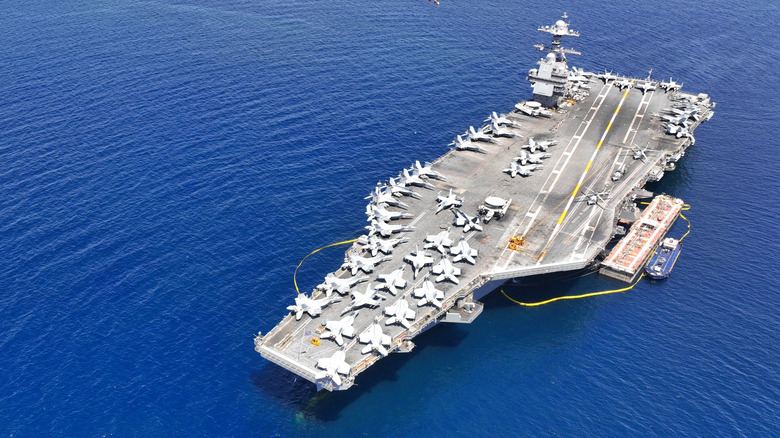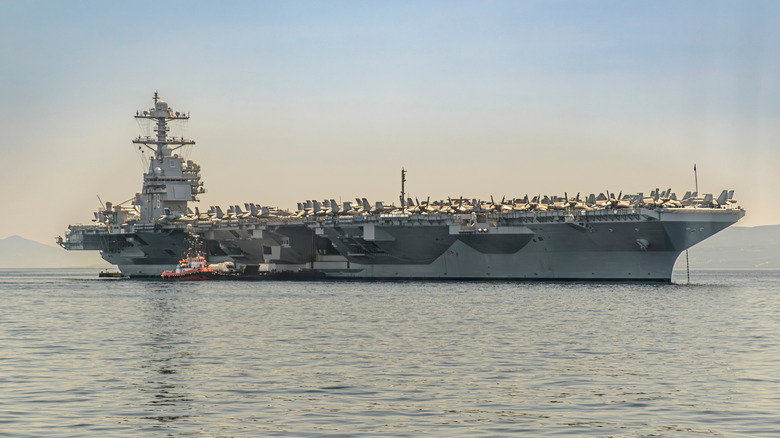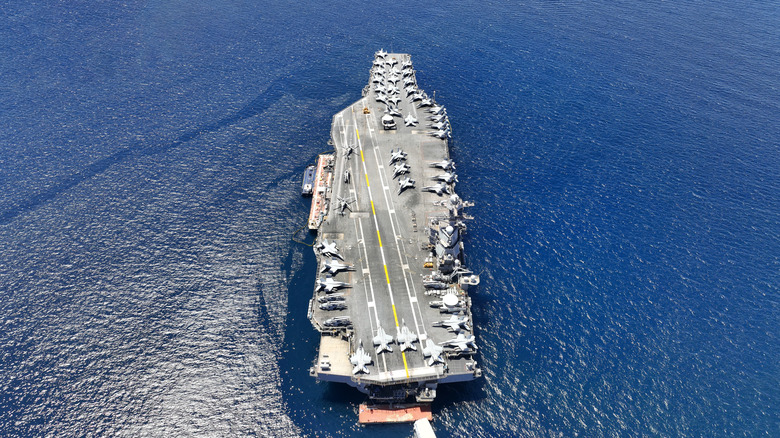This Is The Most Advanced Aircraft Carrier In The World
The USS Gerald R. Ford (CVN-78) is the lead ship of the Navy's newest aircraft carrier class and the most technologically advanced carrier in the world. Delivered in 2017, it replaced the USS Enterprise (CVN-65) after more than five decades of service. The Ford brings more than 23 new or upgraded systems compared to the Nimitz-class, including two A1B nuclear reactors producing 150% more electrical power, enough to operate current systems and future weapons like directed-energy arms. Designed for efficiency, it operates with nearly 700 fewer crew members than Nimitz-class carriers, saving over $4 billion in ownership costs over its 50-year lifespan.
Its reimagined flight deck, with a smaller, relocated island and three deck-edge elevators instead of four, supports up to 160 sorties per day, surging to 220 in combat. The Electromagnetic Aircraft Launch System (EMALS) replaces steam catapults, allowing smoother launches for a wider variety of aircraft, including unmanned systems. The Advanced Arresting Gear (AAG) reduces wear on planes and pilots during recovery. Dual-band radar integrates X-band and S-band systems for superior tracking and targeting.
Weapons elevators move ordnance from magazines to the flight deck faster, increasing turnaround times for strike missions. With capacity for up to 90 aircraft, including the F-35C, F/A-18E/F Super Hornet, E-2D Hawkeye, EA-18G Growler, and MH-60 helicopters, the Ford is built to dominate the air and sea. More than a warship, it's a strategic platform for global presence and power projection, ensuring the U.S. Navy maintains carrier supremacy well into the future.
Proven performance in deployment and training
The Gerald R. Ford's journey from construction to operational deployment reflects years of testing, refinement, and lessons from 6 innovative aircraft carriers from the past. Its keel was laid in 2009, it was christened in 2013, and commissioned in 2017. The first fixed-wing landing occurred just days after commissioning, with an F/A-18F Super Hornet performing an arrested landing using the AAG. Between 2019 and 2021, the ship completed an 18-month Post-Delivery Test and Trials period, conducting 11 Independent Steaming Events and enduring Full Ship Shock Trials (three 40,000-pound underwater blasts) to prove its survivability in simulated combat conditions.
Flight Deck Certification and Carrier Air Traffic Control Center Certification were completed in March 2022, with Carrier Air Wing 8 conducting operations to demonstrate capability. In 2023, under Capt. Rick Burgess, the Ford completed its first operational deployment, sailing 101,681 nautical miles, launching over 10,000 aircraft sorties, and working with 17 allied nations. It earned two Battle "E" Efficiency awards, two CNO Aviation Safety Awards, the Rear Admiral James "Jig Dog" Ramage Award, and the Battenberg Cup for best all-around ship in the Fleet.
By June 2025, the Ford was preparing for its second deployment with a strike group including five guided-missile destroyers and Carrier Air Wing 8. In July 2025, it entered the Mediterranean after transiting the Strait of Gibraltar, marking another milestone in its operational history. Each deployment demonstrates the ship's ability to integrate cutting-edge systems into real-world missions.
Designed for today, ready for tomorrow
While the Ford is unmatched in today's carrier operations, its design ensures adaptability for decades to come. The nuclear propulsion system delivers both speed (over 30 knots) and the electrical capacity to integrate future systems without structural overhauls. Modular internal spaces allow rapid reconfiguration for new technologies, while the deck layout and weapons handling systems are optimized for future unmanned and autonomous aircraft operations.
The ship's survivability has been validated through rigorous trials, and its systems are hardened for contested environments. Advanced automation not only reduces crew workload but also improves damage control efficiency in combat. EMALS and AAG provide launch and recovery capabilities for a wider variety of aircraft with reduced stress on airframes. The dual-band radar offers enhanced situational awareness in complex threat environments, and the ship's weapons (including Evolved Sea Sparrow Missiles and Rolling Airframe Missiles) provide layered defense against modern threats.
Beyond its current role, the Ford is a platform for future naval warfare concepts. Its electrical surplus and flexible design make it a prime candidate for integrating directed-energy weapons and other next-generation systems. With additional ships in the class like the USS John F. Kennedy and the USS Enterprise (although it won't launch for a couple of years) following in its wake, the Ford-class will form the backbone of U.S. naval power projection for the next half-century.


